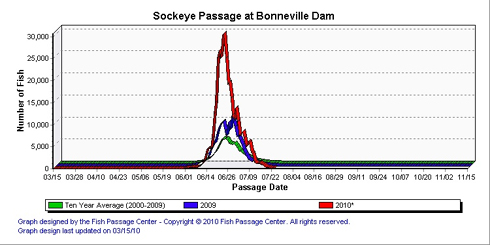Record Salmon Return Explained
This year’s record salmon returns are a mystery to some folks, such as wildlife agency functionaries, but not to us.
Sockeye Count Easily Surpasses 1947
Record Run; ‘Unexpected And Hard To Explain’
The Columbia Basin Bulletin, July 09, 2010 [here]
Sockeye salmon continue to zoom up and over the lower Columbia River’s Bonneville Dam where they are now setting records daily.
The 2010 sockeye count at Bonneville’s fish ladders through Thursday had climbed to 364,019. Before this year, the record sockeye return to the Columbia, which includes fish caught in non-Indian commercial fisheries in the 146 river miles below Bonneville and the dam count, was 335,300 fish in 1947.
Note: as of July 25th the Bonneville sockeye count was 386,071.
The 2010 Bonneville count passed that 1947 mark on Independence Day.
Gill netters harvested 164,200 sockeye (574,000 pounds) in 1947 and 171,139 were counted passing Bonneville, according to data compiled by the Oregon and Washington departments of fish and wildlife. The two agencies co-manage mainstem fisheries on the mainstem Columbia.
The Technical Advisory Committee updated its 2010 sockeye run-size forecast last week to 375,000 fish. The preseason forecast was for a return of 125,000 sockeye to the mouth of the Columbia, but skyrocketing daily counts at Bonneville pushed the forecast to 250,000 and then to 375,000.
This year’s count also exceeds the record Bonneville count, which was 237,700 fish in 1955. Counts have been under way since 1938.
Virtually all Columbia River sockeye are wild-origin fish, originating predominantly from Osoyoos Lake in Canada, with a smaller proportion from Lake Wenatchee. In the Snake River, only a small number of sockeye have returned each year over the past two decades. But their number spiked in 2008 and 2009 when 909 and 1,219 were counted passing the lower Snake River’s Lower Granite Dam, the eighth hydro project the sockeye pass on their way to central Idaho’s Stanley Basin.
Already this year (through Thursday) 938 sockeye have been counted at Lower Granite. The daily counts there rose steadily to a peak of 162 Tuesday. That count was followed by a tally of 143 on Wednesday and 104 on Thursday. Most of the returning Snake River sockeye are the product of a captive broodstock program.
Note: as of July 25th the Lower Granite sockeye count was 1,925.
The Bonneville sockeye counts peaked from June 20-25 when more than 160,000 climbed over the fish ladders. The counts during that period ranged from 25,011 on June 20 to 30,690 on June 24. The latter count is the highest ever, breaking a record set the previous day (30,374).
The record run is “unexpected and hard to explain,” said the Oregon Department of Fish and Wildlife’s Kathryn Kostow, who also chairs TAC. The committee is made up of federal, state and tribal officials. TAC typically would investigate such “odd events” at season’s end. …
Hard for some people to explain. But the abundantly obvious and evident reason for record salmon runs is the Pacific Decadal Oscillation shift that occurred in 2008, when cool waters replaced warmer waters in the eastern Pacific. Upwelling of cold, nutrient-rich water feeds plankton and subsequently the entire food chain, including salmon.
Ken Schlichte predicted the record salmon runs here at NFTSF [here, here], and so did I [here]. No offense to Ken, but it didn’t take a genius to recognize the obvious, especially after record salmon runs in 2009.
The PDO shift was also predicted at W.I.S.E. in 2008 [here].
Maybe the Oregon Department of Fish and Wildlife ought to read this site. They could learn a lot here, and dispel some of their confusion and misapprehension.
Salmon Report July 25th
As of yesterday (July 24th) 244,384 adult spring Chinook salmon, 94,628 adult summer Chinook salmon, 385,950 Sockeye salmon, and 148,567 Steelhead have passed the Bonneville Dam, heading upstream in the Columbia River system to spawn.
That number (873,529 total) is nearly twice the number of adult salmon and steelhead passing Bonneville last year by July 24th (457,119), and more than twice the ten-year average to-date (423,794).

See [here] for more salmon graphs.
See [here] for more salmon statistics.
